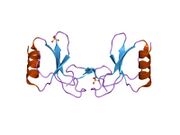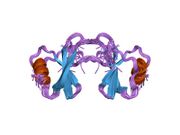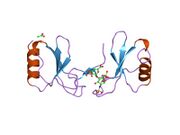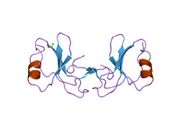Biology:CCL5
 Generic protein structure example |
Chemokine (C-C motif) ligand 5 (also CCL5) is a protein which in humans is encoded by the CCL5 gene.[1] The gene has been discovered in 1990 by in situ hybridisation and it is localised on 17q11.2-q12 chromosome.[2] It is also known as RANTES (regulated on activation, normal T cell expressed and secreted). RANTES was first described by Dr. Tom Schall who named the protein, the original source of the name Rantes was from the Argentine movie Man Facing Southeast about an alien who shows up in a mental ward who was named Rantés, the rather clunky acronym was only made to fit the name.[3]
Function
CCL5 belongs to the CC subfamily of chemokines, due to its adjacent cysteines near N terminus. It is an 8kDa protein acting as a classical chemotactic cytokine or chemokine. It consists of 68 amino acids. CCL5 is proinflammatory chemokine, recruiting leukocytes to the site of inflammation. It is chemotactic for T cells, eosinophils, and basophils, but also for monocytes, natural-killer (NK) cells, dendritic cells and mastocytes.[4] With the help of particular cytokines (i.e., IL-2 and IFN-γ) that are released by T cells, CCL5 also induces the proliferation and activation of certain NK cells to form CHAK (CC-Chemokine-activated killer) cells.[5] It is also an HIV-suppressive factor released from CD8+ T cells [6]
The chemokine CCL5 is mainly expressed by T-cells and monocytes,[7] and it has not been shown to be expressed by B-cells.[8] Moreover, it is abundantly expressed by epithelial cells, fibroblasts and thrombocytes. Although it can bind to receptors CCR1, CCR3, CCR4 and CCR5, belonging to seven transmembrane G-protein coupled receptor (GPCRs) family,[4] it has the highest affinity to the CCR5. CCR5 is presented on the surface of T-cells, smooth muscle endothelial cells, epithelial cells, parenchymal cells and other cell types. After the binding of CCL5 to CCR5, phosphoinositide 3-kinase (PI3K) is phosphorylated and subsequently, the phosphorylated PI3K phosphorylates protein kinase B (PKB; also known as Akt) on the serine 473. Then, the Akt/PKB complex phosphorylates and inactivates a serine/threonine protein kinase GSK-3. After the CCL5/CCR5 binding, some other proteins are regulated as well. Bcl2 is more expressed and it induces apoptosis. Beta-catenin is phosphorylated and degraded. An important protein in the cell cycle, Cyclin D, is inhibited by inactivated GSK-3.[7]
CCL5 was first identified in a search for genes expressed "late" (3–5 days) after T cell activation. It was subsequently determined to be a CC chemokine and expressed in more than 100 human diseases. RANTES expression is regulated in T lymphocytes by Kruppel like factor 13 (KLF13).[9][10][11][12] The CCL5 gene is activated after 3–5 days after activation of T-cell via TCR. This is different from the most of other chemokines which are released almost immediately after cell stimulation. Thus, CCL5 is involved in inflammation maintaining. It also induces expression of matrix metalloproteinases which are important for migration of cells into the site of inflammation.[8] CCL5 may be also expressed by NK cells. SP1 transcription factor binds near to CCL5 gene and mediates its constitutive mRNA transcription. The transcription factor is regulated by the JNK/MAPK pathway.[13] Memory CD8+ T-cells are able to secrete CCL5 immediately after TCR stimulation, because they have a large number of preformed CCL5 mRNA in cytoplasm and its secretion is dependent only on translation.[14]
RANTES, along with the related chemokines MIP-1alpha and MIP-1beta, has been identified as a natural HIV-suppressive factor secreted by activated CD8+ T cells and other immune cells.[6] The RANTES protein has been engineered for in vivo production by Lactobacillus bacteria, and this solution is being developed into a possible HIV entry-inhibiting topical microbicide.[15]
Interactions
CCL5 has been shown to interact with CCR3,[16][17] CCR5[17][18][19][20] and CCR1.[17][19]
CCL5 also activates the G-protein coupled receptor GPR75.[21]
CCL5 has two mechanisms of action according to its concentration.
- The first one occurs at low concentration of the chemokine. CCL5 may act as a monomer or a dimer. Dimerization is not necessary for binding to CCR5. Thus, CCL5 in nanomolar concentration acts as classical chemokine and binds to its receptor. For the acting as classical chemokine and for the dimerization, N terminus of the molecule is important.
- The second one occurs at high concentration of the chemokine. CCL5 creates self-aggregates binding to glycosaminoglycans (GAGs) on the cell surface. For that, Glu66 and Glu26 are important. These amino acids are presented on the protein surface and allows ion interactions. In the experiment where these molecules were exchanged for serine, the self-aggregation did not occur.[22] In vitro, the self-aggregates are strong activators of leukocytes. They can act as mitogens and they are not dependent on binding to the receptor. Activated T-cells (or other cells, for instance monocytes or neutrophils) either proliferate or perform apoptosis, and they release proinflammatory cytokines, such as IL-2, IL-5 and IFN-γ.[4] CCL5 mediated apoptosis in T-cells includes release of cytochrome c in cytoplasm and the activation of caspase-9 and caspase-3. The apoptosis is dependent on GAGs binding on cell surface and there is a requirement of at least 4 CCL5 molecules to induce the apoptosis.[23]
Clinical significance
CCL5 is involved in transplantations,[8] anti-viral immunity,[4] tumor development [24] and numerous human diseases and disorders, for instance viral hepatitis or COVID-19.[2][7]
For instance, CCL5 level is higher during rejection of renal transplant.[8]
Importance of CCL5 is proved by various microbial strategies to avoid the activity of chemokine. For instance, human cytomegalovirus (HCMV) express a viral chemokine receptor analogue US28, which sequesters CCL5. The chemokine is released by virus-specific activated CD8+ T-cells together with perforin and granzyme A. In cytotoxic T-cells (CTL) killing other cells via Fas/FasL interaction, CCL5 increases HIV-specific T-cell cytotoxicity. Moreover, it is considered that CCL5 in low concentration might inhibit HIV replication. It binds to CCR5 (as well as 2 other chemokines) on the surface of CD4+ T-cells. CCR5 is used by HIV as an entrance molecule to a cell. On the contrary, CCL5 in high concentration might increase HIV replication.[4] The chemokine is involved also in antiviral response against other viruses. For instance, it has been shown that CCL5 is highly expressed in mice infected by lymphocytic choriomeningitis virus. In CCL5 knock-out mice, virus-specific CD8+ T cells had reduced cytotoxic ability, reduced cytokines production and enhanced production of inhibitory molecules. It underscores the importance of CCL5 during chronic viral infection.[25]
Increased levels of CCL5 was discovered in lots of cancers. For instance in breast cancer,[24] hepatocellular carcinoma,[2] stomach cancer, prostate cancer and pancreatic cancer.[7]
CCL5 plays an important role in various human disorders, such as atherosclerosis, COVID-19, SARS,[7] atopic dermatitis, asthma, glomerulonephritis,[4] alcohol liver disease, acute liver failure and viral hepatitis.[2]
See also
References
- ↑ "Localization of a human T-cell-specific gene, RANTES (D17S136E), to chromosome 17q11.2-q12". Genomics 6 (3): 548–553. March 1990. doi:10.1016/0888-7543(90)90485-D. PMID 1691736.
- ↑ 2.0 2.1 2.2 2.3 "Functional roles of CCL5/RANTES in liver disease". Liver Research 4 (1): 28–34. 2020-03-01. doi:10.1016/j.livres.2020.01.002.
- ↑ "Hooked on HIV - What's the connection between a 1980s film character and the cutting edge of AIDS research? Philip Cohen reports on a protein that's unlocking HIV's mysteries". Copyright New Scientist Ltd.. 14 December 1996. https://www.newscientist.com/article/mg15220603-700-hooked-on-hiv-whats-the-connection-between-a-1980s-film-character-and-the-cutting-edge-of-aids-research-philip-cohen-reports-on-a-protein-thats-unlocking-hivs-mysteries/#ixzz768mxV32v.
- ↑ 4.0 4.1 4.2 4.3 4.4 4.5 "RANTES: a versatile and controversial chemokine" (in en). Trends in Immunology 22 (2): 83–87. January 2001. doi:10.1016/S1471-4906(00)01812-3. PMID 11286708.
- ↑ "CC chemokines induce the generation of killer cells from CD56+ cells". European Journal of Immunology 26 (2): 315–319. February 1996. doi:10.1002/eji.1830260207. PMID 8617297.
- ↑ 6.0 6.1 "Identification of RANTES, MIP-1 alpha, and MIP-1 beta as the major HIV-suppressive factors produced by CD8+ T cells". Science 270 (5243): 1811–1815. December 1995. doi:10.1126/science.270.5243.1811. PMID 8525373. Bibcode: 1995Sci...270.1811C. https://zenodo.org/record/1231052.
- ↑ 7.0 7.1 7.2 7.3 7.4 "CCL5/CCR5 axis in human diseases and related treatments". Genes & Diseases 9 (1): 12–27. January 2022. doi:10.1016/j.gendis.2021.08.004. PMID 34514075.
- ↑ 8.0 8.1 8.2 8.3 "Mechanisms of disease: regulation of RANTES (CCL5) in renal disease". Nature Clinical Practice. Nephrology 3 (3): 164–170. March 2007. doi:10.1038/ncpneph0418. PMID 17322928.
- ↑ "A human T cell-specific molecule is a member of a new gene family". Journal of Immunology 141 (3): 1018–1025. August 1988. doi:10.4049/jimmunol.141.3.1018. PMID 2456327. http://www.jimmunol.org/cgi/pmidlookup?view=long&pmid=2456327.
- ↑ Alan M. Krensky (1995). Biology of the Chemokine in Rantes (Molecular Biology Intelligence Unit). R G Landes Co.. ISBN 978-1-57059-253-9.
- ↑ "RFLAT-1: a new zinc finger transcription factor that activates RANTES gene expression in T lymphocytes". Immunity 10 (1): 93–103. January 1999. doi:10.1016/S1074-7613(00)80010-2. PMID 10023774.
- ↑ "Transcriptional regulation of RANTES expression in T lymphocytes". Immunological Reviews 177: 236–245. October 2000. doi:10.1034/j.1600-065X.2000.17610.x. PMID 11138780.
- ↑ "JNK MAPK pathway regulates constitutive transcription of CCL5 by human NK cells through SP1". Journal of Immunology 182 (2): 1011–1020. January 2009. doi:10.4049/jimmunol.182.2.1011. PMID 19124744.
- ↑ "RANTES production by memory phenotype T cells is controlled by a posttranscriptional, TCR-dependent process". Immunity 17 (5): 605–615. November 2002. doi:10.1016/S1074-7613(02)00456-9. PMID 12433367.
- ↑ "Engineering of Lactobacillus jensenii to secrete RANTES and a CCR5 antagonist analogue as live HIV-1 blockers". Antimicrobial Agents and Chemotherapy 54 (7): 2994–3001. July 2010. doi:10.1128/AAC.01492-09. PMID 20479208.*Lay summary in: "Microbicide containing engineered bacteria may inhibit HIV-1". July 24, 2010. https://www.sciencedaily.com/releases/2010/07/100721153305.htm.
- ↑ "Cloning, expression, and characterization of the human eosinophil eotaxin receptor". The Journal of Experimental Medicine 183 (5): 2349–2354. May 1996. doi:10.1084/jem.183.5.2349. PMID 8642344.
- ↑ 17.0 17.1 17.2 "Diverging binding capacities of natural LD78beta isoforms of macrophage inflammatory protein-1alpha to the CC chemokine receptors 1, 3 and 5 affect their anti-HIV-1 activity and chemotactic potencies for neutrophils and eosinophils". European Journal of Immunology 31 (7): 2170–2178. July 2001. doi:10.1002/1521-4141(200107)31:7<2170::AID-IMMU2170>3.0.CO;2-D. PMID 11449371.
- ↑ "Interaction of RANTES with syndecan-1 and syndecan-4 expressed by human primary macrophages". Biochimica et Biophysica Acta (BBA) - Biomembranes 1617 (1–2): 80–88. October 2003. doi:10.1016/j.bbamem.2003.09.006. PMID 14637022.
- ↑ 19.0 19.1 "The BBXB motif of RANTES is the principal site for heparin binding and controls receptor selectivity". The Journal of Biological Chemistry 276 (14): 10620–10626. April 2001. doi:10.1074/jbc.M010867200. PMID 11116158.
- ↑ "Distribution of functional polymorphic variants of inflammation-related genes RANTES and CCR5 in long-lived individuals". Cytokine 58 (1): 10–13. April 2012. doi:10.1016/j.cyto.2011.12.021. PMID 22265023.
- ↑ "RANTES stimulates Ca2+ mobilization and inositol trisphosphate (IP3) formation in cells transfected with G protein-coupled receptor 75". British Journal of Pharmacology 149 (5): 490–497. November 2006. doi:10.1038/sj.bjp.0706909. PMID 17001303.
- ↑ "Aggregation of RANTES is responsible for its inflammatory properties. Characterization of nonaggregating, noninflammatory RANTES mutants". The Journal of Biological Chemistry 274 (39): 27505–27512. September 1999. doi:10.1074/jbc.274.39.27505. PMID 10488085.
- ↑ "CCL5-CCR5-mediated apoptosis in T cells: Requirement for glycosaminoglycan binding and CCL5 aggregation". The Journal of Biological Chemistry 281 (35): 25184–25194. September 2006. doi:10.1074/jbc.M603912200. PMID 16807236.
- ↑ 24.0 24.1 "CCL5 as a potential immunotherapeutic target in triple-negative breast cancer". Cellular & Molecular Immunology 10 (4): 303–310. July 2013. doi:10.1038/cmi.2012.69. PMID 23376885.
- ↑ "A role for the chemokine RANTES in regulating CD8 T cell responses during chronic viral infection". PLOS Pathogens 7 (7): e1002098. July 2011. doi:10.1371/journal.ppat.1002098. PMID 21814510.
External links
- Human CCL5 genome location and CCL5 gene details page in the UCSC Genome Browser.
- Overview of all the structural information available in the PDB for UniProt: P13501 (C-C motif chemokine 5) at the PDBe-KB.
Further reading
- "HIV-1 Vpr and anti-inflammatory activity". DNA and Cell Biology 23 (4): 239–247. April 2004. doi:10.1089/104454904773819824. PMID 15142381.
- "Viral infections and cell cycle G2/M regulation". Cell Research 15 (3): 143–149. March 2005. doi:10.1038/sj.cr.7290279. PMID 15780175.
- "HIV-1 viral protein R (Vpr) & host cellular responses". The Indian Journal of Medical Research 121 (4): 270–286. April 2005. PMID 15817944.
- "Roles of HIV-1 auxiliary proteins in viral pathogenesis and host-pathogen interactions". Cell Research 15 (11–12): 923–934. 2006. doi:10.1038/sj.cr.7290370. PMID 16354571.
- "RANTES stimulates Ca2+ mobilization and inositol trisphosphate (IP3) formation in cells transfected with G protein-coupled receptor 75". British Journal of Pharmacology 149 (5): 490–497. November 2006. doi:10.1038/sj.bjp.0706909. PMID 17001303.
 |










